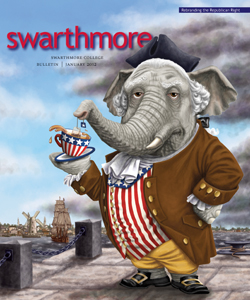Fashion’s Darling
Joseph Altuzarra ’05 has emerged as a hot New York designer.
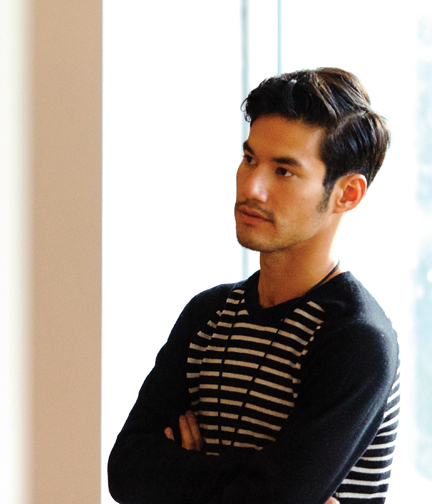
In November, Altuzarra won the Council of Fashion Designers/Vogue Fashion Fund award, which honors promise among emerging designers. The prize, which comes with $300,000 and mentoring, was announced at a dinner that featured Calvin Klein, Diane Von Furstenburg, Anna Wintour, and other industry luminaries.
A FASHION SHOW IS A FAST THING, EXPERIENCED IN IMPRESSIONS. A tight black dress of perforated leather. Long, light, white jackets, silky and sheer or sleeveless. A puckered white belted dress with a black plastic buckle and black leather panels padding the shoulders. A pop of color: A tropical bird print, parrots and parakeets. Chunky canary and moss knits. A brief excursion into cream and rust red, quilted motorcycle jackets and skirts with racing stripes. Black and white again for the finish—hard leathery looks comingling with soft ones, a white dress with a flouncing hem. When the designer, Joseph Altuzarra ’05, comes out for his customary wave, he, too, wears black and white, and jeans.
Altuzarra describes his spring 2012 collection as sport and utility wear melded with a kitschy, tropical vibe. At the show, held at the Chelsea Art Gallery during New York Fashion Week, models with thickly painted eyebrows walk against a backdrop of greenery to a pulsing techno beat. “I wanted to create this weird tension between something that’s hyper-urban and something that’s almost exaggeratedly natural,” Altuzarra says.
The 28-year-old Altuzarra has emerged as a major figure in the fashion industry, his designs in the pages of Vogue and on Jennifer Aniston on the cover of Marie Claire. Mary J. Blige, Kim Kardashian, and Emma Watson have worn his clothing. A maple coat of coyote fur from his fall 2011 collection sells at Barneys for $21,375. Compare this to seven years ago when Altuzarra was showing his designs in Tarble All-Campus Space and Lang Performing Arts Center (LPAC). A Phoenix article on his third and final Swarthmore show during his senior year ends by noting that the collection would be on sale, his pieces starting at $50.
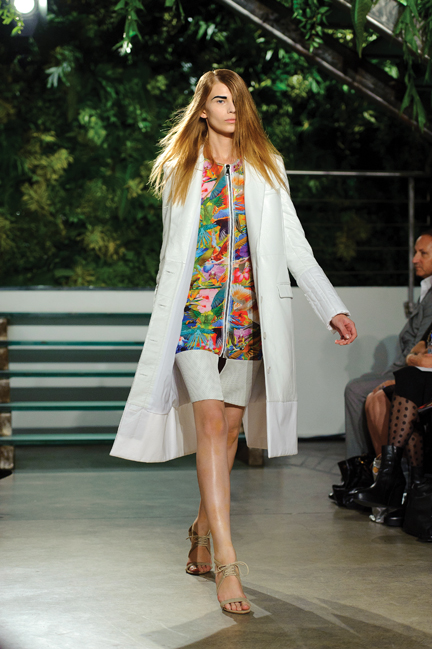 “I came to fashion design through the back door of art history at Swarthmore,” Altuzarra says. “A lot of my papers centered on advertising—how fashion advertising was drawing on very classical art-historical iconography.”
“I came to fashion design through the back door of art history at Swarthmore,” Altuzarra says. “A lot of my papers centered on advertising—how fashion advertising was drawing on very classical art-historical iconography.”
“As I went forward at Swarthmore, it became more and more apparent that fashion was something that I really was interested in. I was going to be an art history major, and I switched to art and decided to just teach myself fashion design.” He did it through the costume workshop in the Theater Department, taught by Susan Smythe.
“He just appeared in the costume shop like Athena out of the head of Zeus,” says Smythe, who was managing director of LPAC and costume shop manager from 1994 until 2006. (She is now Swarthmore’s Americans with Disabilities Act program manager). “He had a really strong eye and a natural ability, but he had no idea how to sew.”
He learned quickly. “He was very self-motivated and driven,” Smythe recalls. “You so rarely see someone going after what they want to do so clearly.”
His senior year, Altuzarra left Swarthmore a week before graduation to begin an internship at Marc Jacobs in New York, later moving to Paris, his hometown, to work as a design assistant for Givenchy. In 2008, he returned to New York to launch his own line and was immediately, in the words of The New York Times, “lionized, and scrutinized” by celebrities and editors “all eager to embrace him as fashion’s Next New Thing.” As early as January 2009, Style.com called Altuzarra “fashion’s new one to know” and described his designs as “a reason to look forward to Fashion Week.”
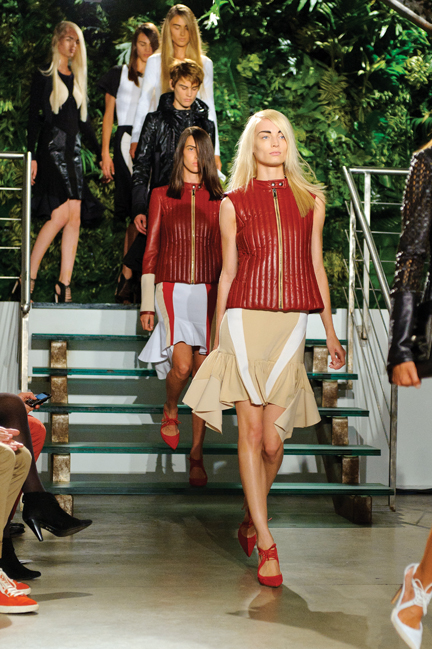 “When I first saw his clothes, I was pretty much flattened by them,” says Cindi Leive ’88, the editor-in-chief of Glamour magazine.
“When I first saw his clothes, I was pretty much flattened by them,” says Cindi Leive ’88, the editor-in-chief of Glamour magazine.
“There’s a confidence about his clothes,” she explains. “There’s an over-styled, over-girlyness about a lot of fashion right now, but his clothes have a very simple, strong quality about them. They don’t need to be tricked up with a million things or over-styled. They speak for themselves.”
In speaking of his design aesthetic, Altuzarra says: “I wanted to dress women of different ages. A big part of the market today is geared toward making 20-year-olds look really sexy, and ultimately there are not that many 20-somethings who have the cash to buy those clothes. Women who are 40 and 50 and 60 today also want to feel seductive and sexy.
“There is something really womanly about the clothes—very, very feminine, but really, really interesting.”
To rewind a few seasons, his spring 2011 collection defined and delineated the female body, “almost abstracting it” with pointy conical bras, Altuzarra says. Inspired by the disjunction of the Internet, the proliferation of images, of random referents, the collection combined primal python with futuristic metallics and traditional couture fabrics, like duchess satin. For fall 2011, Altuzarra’s inspiration was the 1990s, Kate Moss, Oasis-mania: fur-lined parkas over silk slip dresses.
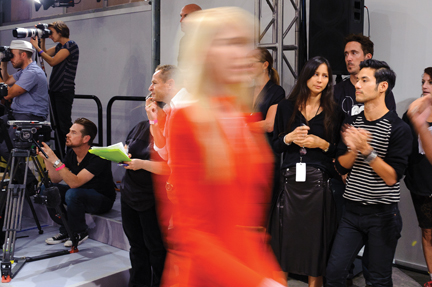
Altuzarra (in striped shirt) presented his spring 2012 designs during New York Fashion Week in September. He says he was going to major in art history at Swarthmore but switched to studio art and decided to teach himself fashion design.
His most recent collection, for spring 2012, with its focus on outerwear, utility, sport, and print, represented the first time, he says, “that we’re really evolving our language from one season to the next, as opposed to revolutionizing it.”
Altuzarra describes his design process as primarily two-dimensional. “I’m much more about drawing than I am about constructing something on a form.” During the weeks he is drawing, he works from 5 p.m. to 5 a.m., barely emerging from his apartment except to walk his schnauzer, Bean (who, incidentally, sported her own version of an Altuzarra fox fur-lined parka last fall in a Bergdorf Goodman fashion show for dogs).
“I think fashion gets a bad rap, for being a very superficial industry and for being very cut off from reality—because the clothes are so expensive, and we’re trying to sell things to people they don’t really need,” Altuzarra says. “But I think fashion is very important, because it’s a multimillion dollar industry that supports a lot of craft, ultimately. In France and Italy, there are communities that specialize in very specific crafts, and fashion is really the only industry that is supporting them, that is allowing them to still thrive and live on.”
Elizabeth Redden is an instructor of composition and a freelance writer. Her articles and essays have appeared in a variety of publications including Gastronomica, Inside Higher Ed, and Orion.
 Email This Page
Email This Page